上海牛津英语5AM3U2教案
- 格式:doc
- 大小:116.50 KB
- 文档页数:10
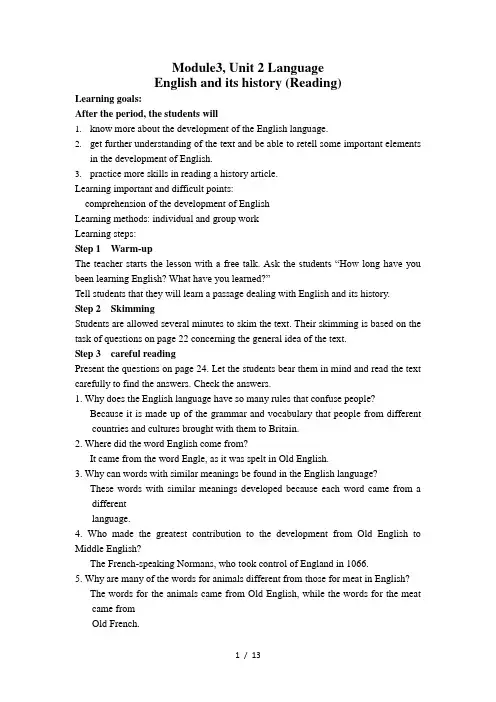
Module3, Unit 2 LanguageEnglish and its history (Reading)Learning goals:After the period, the students will1.know more about the development of the English language.2.get further understanding of the text and be able to retell some important elementsin the development of English.3.practice more skills in reading a history article.Learning important and difficult points:comprehension of the development of EnglishLearning methods: individual and group workLearning steps:Step 1 Warm-upThe teacher s tarts the lesson with a free talk. Ask the students “How long have you been learning English? What have you learned?”Tell students that they will learn a passage dealing with English and its history.Step 2 SkimmingStudents are allowed several minutes to skim the text. Their skimming is based on the task of questions on page 22 concerning the general idea of the text.Step 3 careful readingPresent the questions on page 24. Let the students bear them in mind and read the text carefully to find the answers. Check the answers.1. Why does the English language have so many rules that confuse people?Because it is made up of the grammar and vocabulary that people from different countries and cultures brought with them to Britain.2. Where did the word English come from?It came from the word Engle, as it was spelt in Old English.3. Why can words with similar meanings be found in the English language?These words with similar meanings developed because each word came from a differentlanguage.4. Who made the greatest contribution to the development from Old English to Middle English?The French-speaking Normans, who took control of England in 1066.5. Why are many of the words for animals different from those for meat in English?The words for the animals came from Old English, while the words for the meat came fromOld French.Step 4 Intensive comprehensionAsk the students to pay attention to the subtitles and divide the text into several parts. The text can be easily divided into 4 parts considering the subtitles, namely, Introduction, Old English, Middle English and Modern English.Part1 IntroductionRead part 1 and find answer to the question “Why English has so many difficult rules?”Because people from many different countries have lived together in Britain and they brought with them the rules and vocabulary into the English language.Part2 Old EnglishPresent a flow chart according to the development of Old English. The teacher can choose to tell the students some basic facts as well as to ask some detailed questions with reference to the chart.And after completing the chart, students will be encouraged to give a short summary of Old English. If necessary, the teacher can give an example as follows:“Before the middle of the 5th century, people spoke Celtic. Then 2 Germanic tribes the Angles, the Saxons occupied Britain. Their language mixed with Celtic and became the base of Old English. At the end of the 9th century, the Vikings, people from countries including Denmark and Norway moved to Britain. And their language mixed with Anglo-Saxon and became what we now call Old English. By the 10th century, Old English was the official language of England.”Part3 Middle EnglishRead part 3 and discuss the answer to the question “What are t he factors that contributed to the development of Middle English?”French and Henry IV.Have a further discussion within groups about the influence resulting from the factors and make a summary of the factors and the effects.Part4 Modern EnglishStudents are asked to finish reading the last part and find answers to the following two questions:When did Modern English appear?During the Renaissance in the 16th century.What new factors are included in modern English?Latin and Greek words, pronunciations and new words and new ways being invented. Step 6 RetellingThe key words are presented on the screen. Students are allowed 5 minutes to prepare retelling the text in pairs.PresentationStudents are encouraged to come to the front and retell the text. The teacher could also ask students to do the retelling one after another, each student one sentence. Step 7 WritingWrite a short summary of English and its history according to what we have learned today.Step8 HomeworkStudents book P98 A1,A2Module3, Unit 2 LanguageEnglish and its history (language focus)Learning goals:After this period, the students willDo some revision of what have been learned in the last lesson.1.lcquire the usage of the language items in the text.2.apply the language items into practical use.Learning important points:Language points in the textLearning steps:Step 1 RevisionThe teacher starts the lesson with a short revision of what have been learned in the previous lessons. This part consists of two activities—to match the words and their definitions and to fill in the blanks.Step 2 PresentationPresent all the language items that should be coved in the following lesson. Ask the students to find them out in the text.Step 3 Discussion of the language items1. consist1) consist in主要是,主要在于Happiness consists in appreciating what you have. 快乐就在于满足所拥有的。
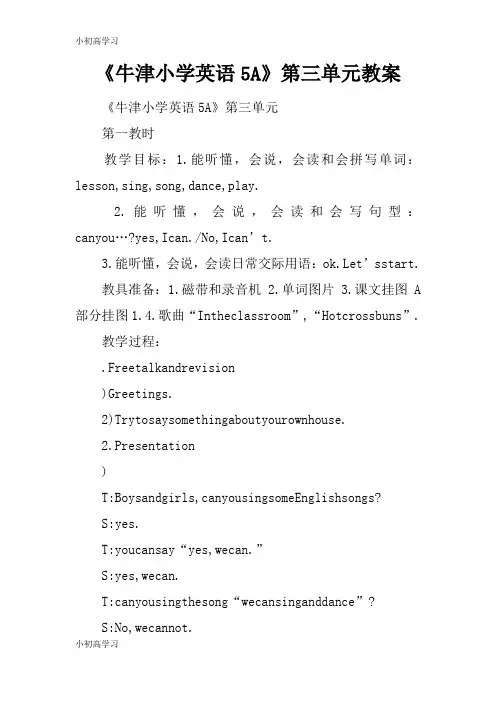
《牛津小学英语5A》第三单元教案《牛津小学英语5A》第三单元第一教时教学目标:1.能听懂,会说,会读和会拼写单词:lesson,sing,song,dance,play.2.能听懂,会说,会读和会写句型:canyou…?yes,Ican./No,Ican’t.3.能听懂,会说,会读日常交际用语:ok.Let’sstart.教具准备:1.磁带和录音机2.单词图片3.课文挂图A 部分挂图1.4.歌曲“Intheclassroom”,“Hotcrossbuns”.教学过程:.Freetalkandrevision)Greetings.2)Trytosaysomethingaboutyourownhouse.2.Presentation)T:Boysandgirls,canyousingsomeEnglishsongs?S:yes.T:youcansay“yes,wecan.”S:yes,wecan.T:canyousingthesong“wecansinganddance”?S:No,wecannot.出示单词:singsongS:跟读。
T:whatcanyousing?S:“ABcsong”,“Intheclassroom”…T:Icansing“TenlittleIndians”,whatcanyousing? S:Icansing“Howareyou?”T:Good.Let’ssing“Howareyou?”first.S:Allright./ok.2)T:Boysandgirls,canyousing?S:yes,wecan.T:canyoudance?S:yes,wecan.T:canyouswim?S:yes,wecan.T:canyouswim?S:yes,Ican./No,Ican’t.出示句型:canyou…?yes,Ican./No,Ican’t.3)T:canyouski?S:yes,Ican./No,Ican’t.T:canyouskate?S:yes,Ican./No,Ican’t.T:Icanplaytheviolin.whatcanyoudo?S:Icanplaythepiano./Icanplaytheguitar.出示单词:ski,swim,skate,playtheviolin,playtheguitar 出示句型:whatcanyoudo?Ican…3.Practice)ShowthepictureofPartc.Thestudentslookatthepict ureofPartcandaskandanswerinpairs:Ican…whatcanyoudo?Ican…2)ShowthepictureofpartAandanswerthequestions:whocanyouseeinthepicture?whataretheydoing?出示:amusiclesson4.consolidation)ListentothetapeofPartAandtrytounderstandit.ReadthetextofPartAonpage22afterthetape.2)Trytoactthetext.5.Homework)copythewords:lesson,sing,song,dance,playDosomewrittenwork第二教时教学目标:1.能听懂,会说,会读和会拼写单词:learn,listen,make,ride,put,can.2.比较熟练的掌握句型:canyou…?yes,Ican./No,Ican’t.3.能听懂,会说,会读日常交际用语:Listento…,please.Now,followme,please.yes./ok./Allr ight.ok.Let’ssingittogether.教具准备:1.磁带和录音机2.模型飞机3.课文挂图A 部分挂图2.4.歌曲“wecansinganddance”.教学过程:.Freetalkandrevision)Greetings2)ActpartAonpage22.2.Presentationandpractice)T:canyousingthesong“wecansinganddance”?s:No,wecan’t.T:Shallwelearnthesong“wecansinganddance”now?S:yes.T:Listentothesong,please.S:ok.T:S:Enjoythesong.T:canyousingitnow?S:yes,wecan.T:Good.Let’ssingittogether.出示单词:listen2)T:(出示模型飞机的组件)Icanmakeamodelplane,whatcanyoudo?出示单词makeS:Icanmakeamodelcar.出示词组makeamodelplane,makeapuppet S:跟读反复练习句型:whatcanyoudo?Ican…3.Practice)chant:A:whatcanyoudo?whatcanyoudo?B:Icanswim,Icanrun.B:whatcanyoudo?whatcanyoudo?c:Icansing,Icandance.......2)ShowthepictureofPartA.Thestudentslookatthepicturean danswerthequestions:whocanyouseeinthepicture?whataretheydoing?whocanplaytheviolin?3)ListentothetapeofPartA4)Readthetext.4.consolidation)分角色朗读课文。
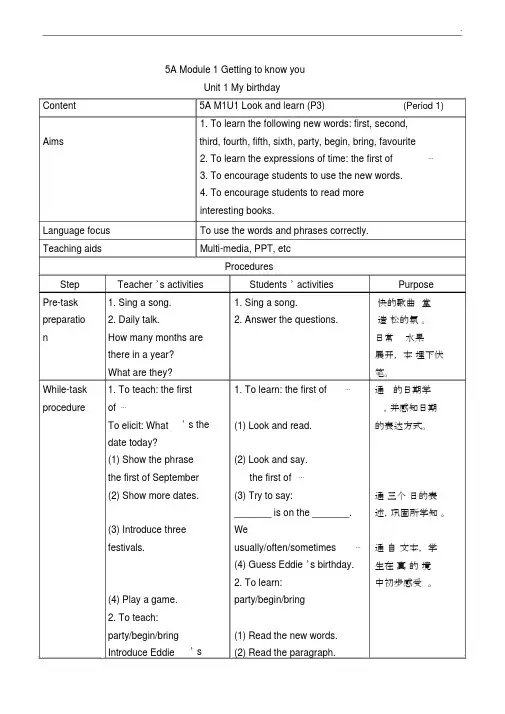
.5A Module 1 Getting to know youUnit 1 My birthdayContent5A M1U1 Look and learn (P3)(Period 1)1. To learn the following new words: first, second,Aims third, fourth, fifth, sixth, party, begin, bring, favourite2. To learn the expressions of time: the first of⋯3.To encourage students to use the new words.4.To encourage students to read moreinteresting books.Language focus To use the words and phrases correctly.Teaching aids Multi-media, PPT, etcProceduresStep Teacher ’s activities Students ’ activities PurposePre-task 1. Sing a song. 1. Sing a song.快的歌曲堂preparatio 2. Daily talk. 2. Answer the questions.造松的氛。
n How many months are日常水果there in a year?展开,本埋下伏What are they?笔。
While-task 1. To teach: the first 1. To learn: the first of⋯通的日期学procedure of ⋯,并感知日期To elicit: What’ s the(1)Look and read.的表达方式。
date today?(1) Show the phrase(2)Look and say.the first of September the first of ⋯(2) Show more dates.(3)Try to say:通三个日的表_______ is on the _______.述,巩固所学知。
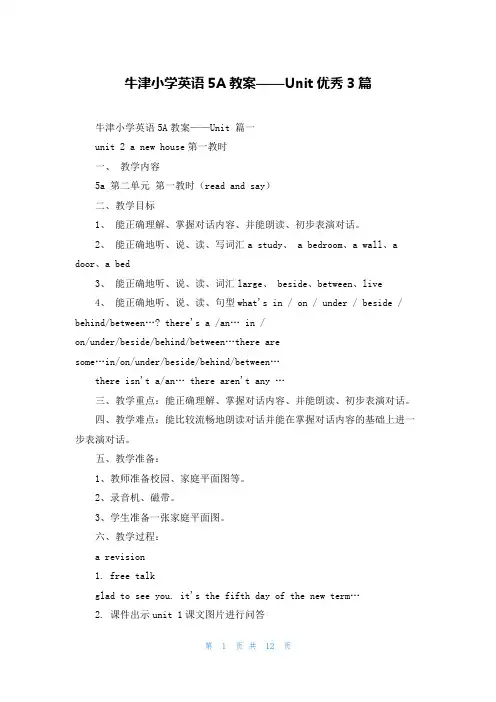
牛津小学英语5A教案——Unit优秀3篇牛津小学英语5A教案——Unit 篇一unit 2 a new house第一教时一、教学内容5a 第二单元第一教时(read and say)二、教学目标1、能正确理解、掌握对话内容、并能朗读、初步表演对话。
2、能正确地听、说、读、写词汇a study、 a bedroom、a wall、a door、a bed3、能正确地听、说、读、词汇large、 beside、between、live4、能正确地听、说、读、句型what's in / on / under / beside / behind/between…? there's a /an… in /on/under/beside/behind/between…there aresome…in/on/under/beside/behind/between…there isn't a/an… there aren't any …三、教学重点:能正确理解、掌握对话内容、并能朗读、初步表演对话。
四、教学难点:能比较流畅地朗读对话并能在掌握对话内容的基础上进一步表演对话。
五、教学准备:1、教师准备校园、家庭平面图等。
2、录音机、磁带。
3、学生准备一张家庭平面图。
六、教学过程:a revision1. free talkglad to see you. it's the fifth day of the new term…2. 课件出示unit 1课文图片进行问答what's in your school? there is a building in my school.how many classrooms are there ? there are …is there a sports hall? yes / noare there any reading rooms in the building? yes, there are /no, there aren't .where're the computer rooms? they 're on the second floor.…b presentation and practice出示课件yang ling家的新居平面图进行问答1. 复习单词a bathroom, a bedroom, a study, a kitchen, a dining-room, a sitting-room.2. 借助图片,教师描述新居的情况。
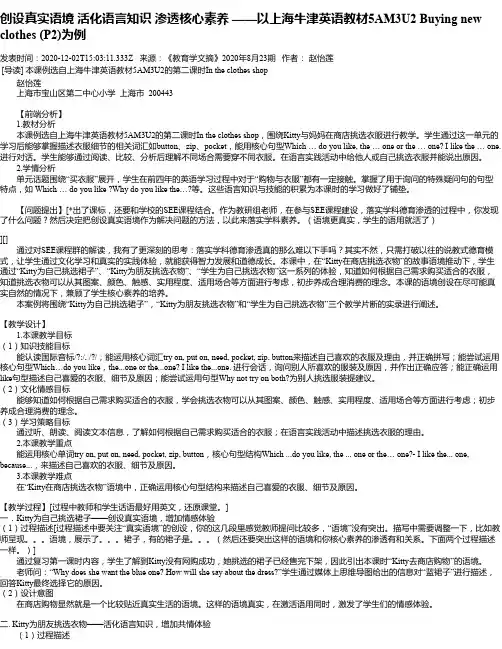
创设真实语境活化语言知识渗透核心素养 ——以上海牛津英语教材5AM3U2 Buying new clothes (P2)为例发表时间:2020-12-02T15:03:11.333Z 来源:《教育学文摘》2020年8月23期作者:赵怡莲[导读] 本课例选自上海牛津英语教材5AM3U2的第二课时In the clothes shop 赵怡莲上海市宝山区第二中心小学上海市 200443 【前端分析】 1.教材分析本课例选自上海牛津英语教材5AM3U2的第二课时In the clothes shop,围绕Kitty与妈妈在商店挑选衣服进行教学。
学生通过这一单元的学习后能够掌握描述衣服细节的相关词汇如button、zip、pocket,能用核心句型Which … do you like, the … one or the … one? I like the … one.进行对话。
学生能够通过阅读、比较、分析后理解不同场合需要穿不同衣服。
在语言实践活动中给他人或自己挑选衣服并能说出原因。
2.学情分析单元话题围绕“买衣服”展开,学生在前四年的英语学习过程中对于“购物与衣服”都有一定接触。
掌握了用于询问的特殊疑问句的句型特点,如 Which … do you like ?Why do you like the…?等。
这些语言知识与技能的积累为本课时的学习做好了铺垫。
【问题提出】[*出了课标,还要和学校的SEE课程结合。
作为教研组老师,在参与SEE课程建设,落实学科德育渗透的过程中,你发现了什么问题?然后决定把创设真实语境作为解决问题的方法,以此来落实学科素养。
(语境更真实,学生的语用就活了)][]通过对SEE课程群的解读,我有了更深刻的思考:落实学科德育渗透真的那么难以下手吗?其实不然,只需打破以往的说教式德育模式,让学生通过文化学习和真实的实践体验,就能获得智力发展和道德成长。
本课中,在“Kitty在商店挑选衣物”的故事语境推动下,学生通过“Kitty为自己挑选裙子”、“Kitty为朋友挑选衣物”、“学生为自己挑选衣物”这一系列的体验,知道如何根据自己需求购买适合的衣服,知道挑选衣物可以从其图案、颜色、触感、实用程度、适用场合等方面进行考虑,初步养成合理消费的理念。
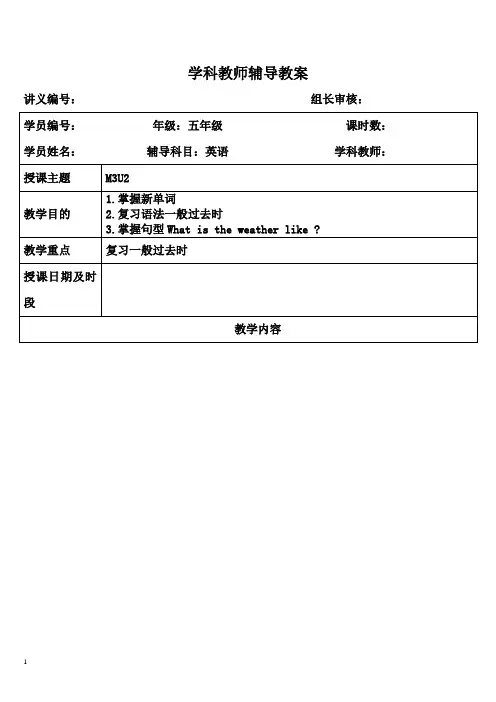
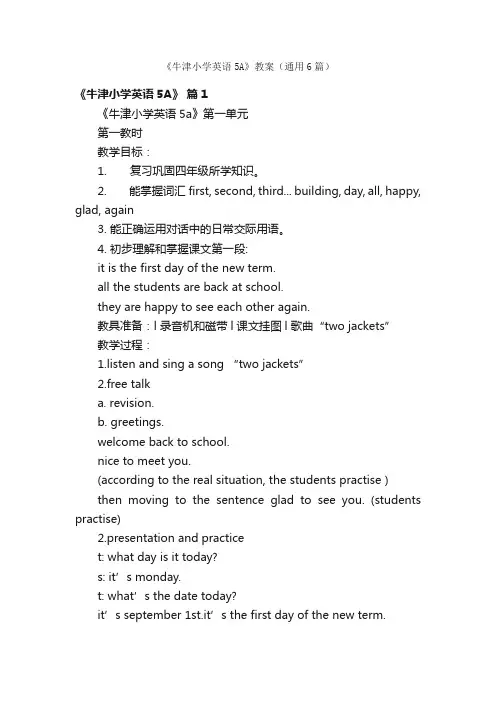
《牛津小学英语5A》教案(通用6篇)《牛津小学英语5A》篇1《牛津小学英语5a》第一单元第一教时教学目标:1. 复习巩固四年级所学知识。
2. 能掌握词汇first, second, third... building, day, all, happy, glad, again3. 能正确运用对话中的日常交际用语。
4. 初步理解和掌握课文第一段:it is the first day of the new term.all the students are back at school.they are happy to see each other again.教具准备:l 录音机和磁带l 课文挂图l 歌曲“two jackets”教学过程:1.listen and sing a song “two jackets”2.free talka. revision.b. greetings.welcome back to school.nice to meet you.(according to the real situation, the students practise )then moving to the sentence glad to see you. (students practise)2.presentation and practicet: what day is it today?s: it’s monday.t: what’s the date tod ay?it’s september 1st.it’s the first day of the new term.(new words: first, day, term)(amplify the structure of “the first ... of the…” )i’m happy. today all the students are back at school.glad to see you.we are happy to see each other again.(new words: all, back, back at school, glad, again, each other) (read and practice them, eg: read, make phrases, etc.)(according to the situation, let the students understand the meaning of the key sentences.)3.look at the picture of the text and answer the questions. (making clear the background)4.a. read and say (paragraph 1)1) listen to the tape2) read after the tape3) read by together5.look at picture 2 , review “there is...”t: there is a new building in the picture.(new word: building)t: how many floors are there in this building?s: four.(new word: floor)learn the name of “the ground floor/the first floor/ the second floor...”t: what’s the name of the rooms in this building? we will learn them next class.6.homework1) talk about our school2) copy the new words3) some translations第二教时教学目标:1. 复习四年级相关知识 a computer room, a music room, a tape recorder, a desk, a chair等。
![沪教版最新版本牛津英语5A教案[1]](https://uimg.taocdn.com/98bc9811e87101f69f31950a.webp)
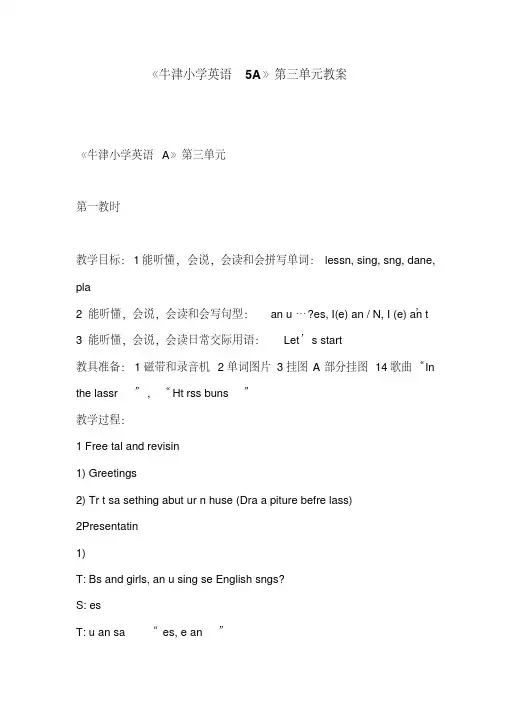
《牛津小学英语5A》第三单元教案《牛津小学英语A》第三单元第一教时教学目标:1能听懂,会说,会读和会拼写单词:lessn, sing, sng, dane, pla2 能听懂,会说,会读和会写句型:an u…?es, I(e) an / N, I (e) an’t3 能听懂,会说,会读日常交际用语:Let’s start教具准备:1磁带和录音机2单词图片3挂图A部分挂图14歌曲“In the lassr”, “Ht rss buns”教学过程:1 Free tal and revisin1) Greetings2) Tr t sa sething abut ur n huse (Dra a piture befre lass)2Presentatin1)T: Bs and girls, an u sing se English sngs?S: esT: u an sa “ es, e an”S: es, e anT: an u sing the sng “e an sing and dane”?S: N, e an nt出示单词:sing sngS: 跟读。
T:hat an u sing?S: “AB sng” , “ In the lassr”…T: I an sing “Ten little Indians”, hat an u sing? S: I an sing “ H are u?”T:Gd Let’s sing “ H are u?” firstS: All right /2)T: Bs and girls, an u sing?S: es, e anT: an u dane? (教师以动作示意)S: es, e anT: an u si?S: es, e anT: (问单个学生) an u si?S: es, I an / N, I an’t出示句型:an u…?es, I an / N, I an’t3)T: an u si?S: es, I an / N, I an’tT: an u sate?S: es, I an / N, I an’tT: I an pla the vilin hat an u d?S: I an pla the pian / I an pla the guitar出示单词:si, si, sate, pla the vilin, pla the guitar出示句型:hat an u d?I an …3Pratie1) Sh the piture f Part The students l at the piture f Part and as an d anser in pairs:I an … hat an u d?I an …2) Sh the piture f part A and anser the questins:h an u see in the piture?hat are the ding? (The are having a usi lessn)出示: a usi lessn4 nslidatin1) Listen t the tape f Part A and tr t understand itRead the text f Part A n page 22 after the tape( nsidering Part A is t lng frthe studentse an divide int t parts and use t lasses t teah the)2) Tr t at the textHer1) p the rds: lessn, sing, sng, dane, plaD se ritten r (Part )第二教时教学目标:1能听懂,会说,会读和会拼写单词:learn, listen, ae, ride, put, an2 比较熟练的掌握句型:an u…?es, I(e) an / N, I (e) an’t 3 能听懂,会说,会读日常交际用语:Listen t … , please N , fll e, please es / / All right Let’s sing it tgether教具准备:1磁带和录音机2模型飞机3挂图A部分挂图24歌曲“e an sing and dane”教学过程:1 Free tal and revisin1) Greetings2) At part A n page 222Presentatin and pratie1)T: an u sing the sng “e an sing and dane”?s: N, e an’tT: Shall e learn the sng “e an sing and dane” n? S: esT:Listen t the sng, pleaseS:T: ( Pla the sng)S: En the sngT:an u sing it n?S: es, e anT: Gd Let’s sing it tgether出示单词:listen2)T: (出示模型飞机的组)I an ae a del plane, hat an u d?出示单词aeS: I an ae a del ar出示词组ae a del plane, ae a puppetS: 跟读反复练习句型:hat an u d?I an…。
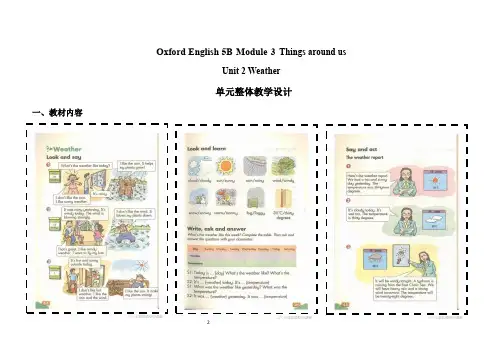
Oxford English 5B Module 3Things around usUnit 2 Weather单元整体教学设计一、教材内容二、单元规划1. 单元内容分析单元主题:Weather2. 单元语言知识内容要求分析3.学情分析4.单元学习目标●知识与技能(1) 能知晓字母组合th的发音规则,尝试根据发音规律正确朗读和认读含有音素/ θ /与/ ð /的单词。
(2) 能在语境中知晓并理解cloud/cloudy, sun/sunny, rain/rainy, wind/windy, snow/snowy, storm/stormy, fog/foggy, temperature, 30℃/thirty degrees等有关自然现象、天气和温度的词汇,能听、读和规范书写。
同时在语境中,知晓并理解这些词汇的含义和正确用法。
(3) 能在语境中运用句型What’s the weather like today? What’s the temperature? What was the weather like yesterday? What wasthe temperature?询问天气和温度并进行正确的应答。
(4) 能在语境中,理解语篇内容,获取相关信息,进行简单复述。
●思维与策略能在课堂学习中,通过问答,讲述,模仿,思考,小组合作等方式,完成学习任务。
●文化与情感了解天气与人类活动的关系,知道和体会不同的天气温度气候对城市居民和农民日常生活的影响。
5. 单元学习任务三、单元学习过程(一)第一课时学习过程1. 话题:The seasons I like2. 学习任务:能描述自己喜欢的季节,并简单阐述理由。
3. 学习目标:●语言理解(1)能初步朗读音素/θ/,感受字母组合th的发音规律(2)通过文本视听、跟读模仿、看图说话等形式学习自然现象和天气类词汇cloud, cloudy, sun, sunny, rain, rainy, wind, windy, snow, snowy, storm, stormy, fog, foggy等词汇,能听、读和规范书写●语言表达(1)能理解并尝试运用句型What’s the weather like?询问天气并进行正确的应答;(2)能描述自己喜欢的季节,并简单阐述理由●思维特征(1)通过倾听、模仿、跟读等形式学习语音。
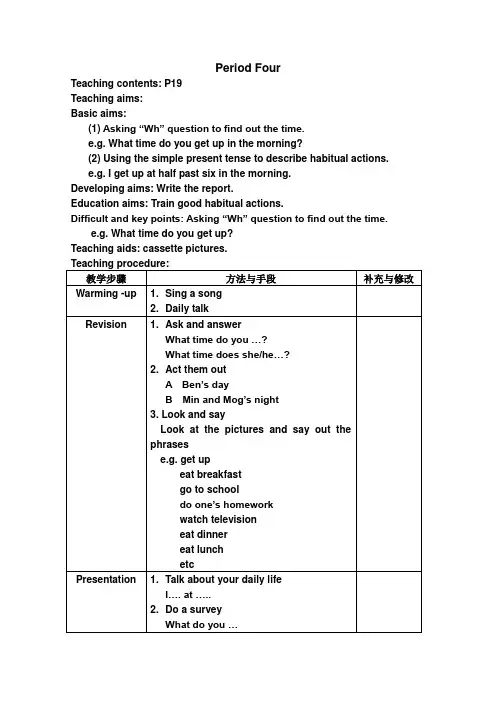
《牛津小学英语5A》第三单元教案共3篇《牛津小学英语5A》第三单元教案1教学目标:1.能听懂、会说、会读、会写以下单词和短语:jump, hopping, skipping, running, flying, spinning, happy, sad, angry, tired, water, juice, tea, milkshake, hot chocolate;2.进一步训练学生听、说、读、写英语的能力,尤其是会话能力;3.能较好地掌握本单元内容,并积极运用所学知识进行交流和互动;4.通过对本单元的学习,提高学生对英语的听、说、读、写的兴趣,激发学生学习英语的热情。
关键词:jump, hopping, skipping, running, flying, spinning, happy, sad, angry, tired, water, juice, tea, milkshake, hot chocolate教学准备:1.教学课件:本单元的PPT或者其他形式的多媒体教学课件;2.教学资料:学生书、教师书、课堂练习用单词卡片、翻译卡片等;3.其他教学工具:黑板、彩笔、CD等教学过程:Step 1: Warm-up1. Review the English alphabet with students.2. Play a game to review the vocabulary of previous units.3. Use TPR (Total Physical Response) to review Unit 1 and Unit 2 words. For example, the teacher says “jump” and the students jump. The teacher says “fly” and the students pretend to fly. Use other actions for other words.Step 2: Presentation1. Introduce the new vocabulary of Unit 3.2. Listen to the CD for the vocabulary pronunciation and practice their pronunciation.3. Drill the new vocabulary with flashcards.Step 3: Practice1. Listening practice: Listen to the CD and play a listening game such as “Listen and Point”.2. Speaking practice: Practice speaking the new vocabulary in pairs or small groups. Use sen tence patterns such as “What can you do?” “I can jump.”3. Reading practice: Read the new vocabulary in the textbook.4. Writing practice: Write down the new vocabulary in the textbook or on the blackboard.Step 4: Extension1. Activity 1: Have students draw pictures of themselves doing different actions (such as jumping, running, spinning, etc.), and then describe what they are doing in English.2. Activity 2: Have students create a dialogue using the new vocabulary. For example, one student can say “I am happy”, and another student can ask “Why are you happy?” and the first student can respond “Because I can jump!”3. Activity 3: Play charades with the new vocabulary. One student acts out a word (such as “angry”), and the other students have to guess what the word is.Step 5: Homework1. Complete the vocabulary exercises in the textbook.2. Write a short paragraph about what they did last weekend using the new vocabulary.3. Practice saying and spelling the new vocabulary words at home.教学反思:1.通过本课的学习,学生能够掌握并运用新的词汇和短语;2.课堂实践和活动能够巩固和提高学生的英语学习兴趣,培养学生对英语的兴趣和热情;3.通过出色的表现来激励学生,促进学生对英语听、说、读、写技能的全面提升。
Module 3 Unit 2Let's go shopping!对家长说本课的学习重点是复习和运用one~one hundred的表达,以及正在进行时的特殊疑问句及其回答。
我们已学习了1- 20的数词。
20一100数词的表达只要掌握twenty (20), thiriy(30), forty (40), fifty (50), sixty (60), seventy (70),eighty (80),ninty (90)和hundred(百)。
由于数词的朗读对学生来说比较拗口,因此要利用尽可能多的机会让学生开口说数词。
可以是钞票的多少,物品的多少,也可以报数。
只有反复操练,才能让学生看到数字即能脱口而出。
在Play a game (Mrs Wang's in the supermarket!)这一游戏,通过对话What is she buying? She's buying...操练现在进行时。
在此基础上教师可以进一步用看图说话的方法帮助学生练习现在进行时。
例:-- - What-s she doing?一She's singing/dancing/writing/…学习目标1.核心词汇Case n.箱,盒,容器money n.钱note n.纸币2.其它词汇Umbrella n.伞dear adj.贵的cheap adj.便宜的Yuan n.元robot n.机器人buy adj.买3.词汇学习1) case(箱,盒)的同义词是box。
如a pencil case(铅笔盒)等于a pencil box。
case和box都可以作量词。
如three cases of eggs(三箱鸡蛋),a box of chocolate(一盒巧克力)2) money(钱)是不可数名词。
如make moncy(赚钱),much money(很多钱)。
I have no money.(我没有钱。
Oxford English (Shanghai Edition)5A Module 3 Unit 2 Buying new clothesTeaching Plan for Oxford English (Shanghai Edition)5A Module 3 Places and activitiesUnit 2 Buying new clothesMaterials:Oxford English (Shanghai Edition) 5A M3 U2 Buying new clothesTeaching aids: Multi-media, word cards, flash, Work sheet, etc教学设计说明学生情况分析:五(1)班学生的英语基础较好,学生们已经积累了不少的词汇量,绝大多数学生能积极参与学习过程,对游戏、竞赛、对子练习、听说活动、故事表演等尤感兴趣。
故事教学几乎在每一单元都有涉及,生动的图片,有趣的情节或是深刻的寓意都让学生比较感兴趣。
学生一般能对图片进行简单的描述,能在老师地引导下进行合理的猜测、想象,并运用已学词汇和句型进行简单的表达。
学生基本能有序地开展个人,两两和小组等不同单位的教学活动。
在学习本单元之前,学生通过四年多的学习,已经积累了部分与服饰相关的词汇;同时,也学习与掌握了与本单元内容密切相关的内容,比如:购物时的常用句型How much....? 了解他人喜好的句型Which ... do you like?以及询问原因的句型--- Why? ---- Because...等,这些知识储备都为本单元的学习奠定了一定的学习基础。
模块教学任务分析:5A M3的模块主题是Places and activities,围绕Around the city(城市之行), Buying new clothes (购买新衣), Seeing the doctor(寻医看病)三个话题展开,均为学生非常熟悉又极具生活性。